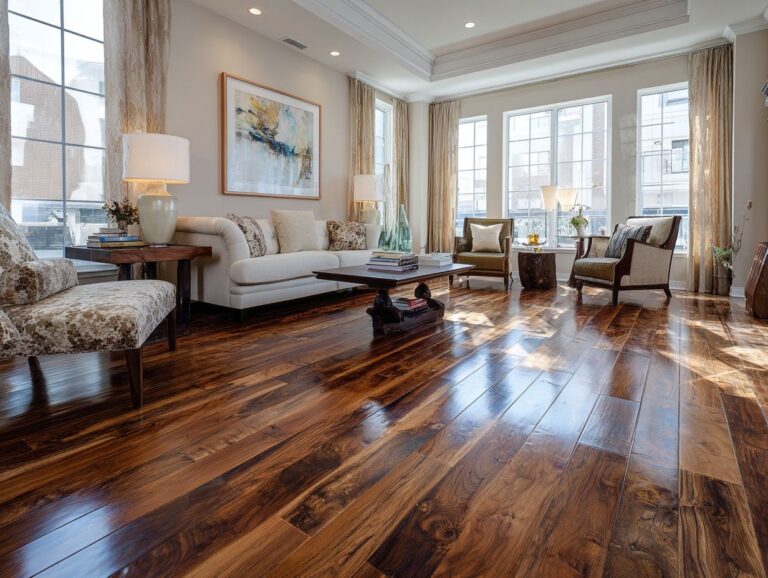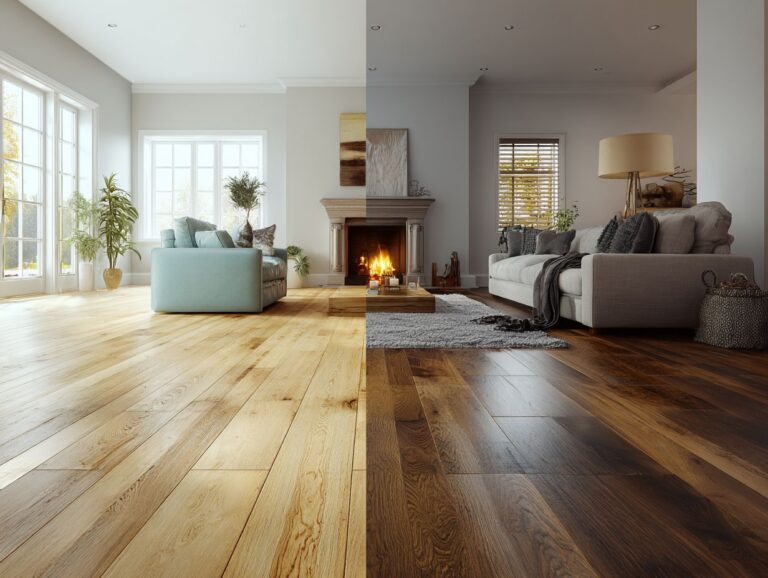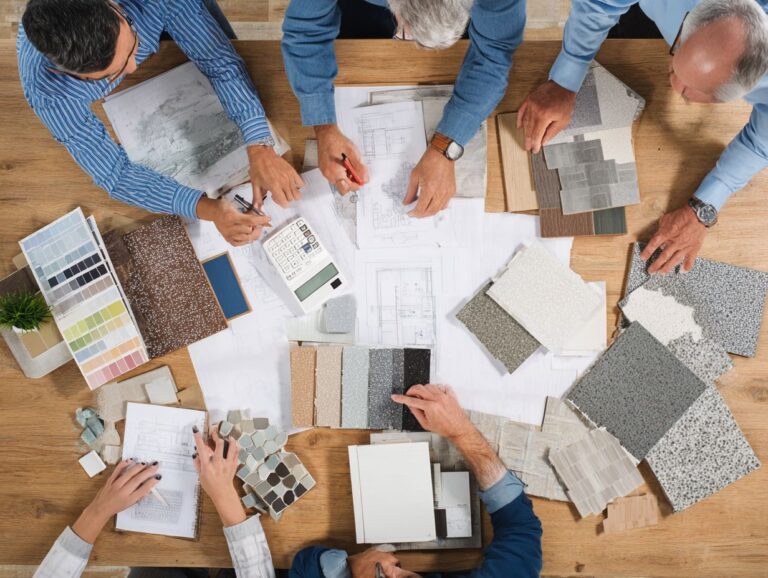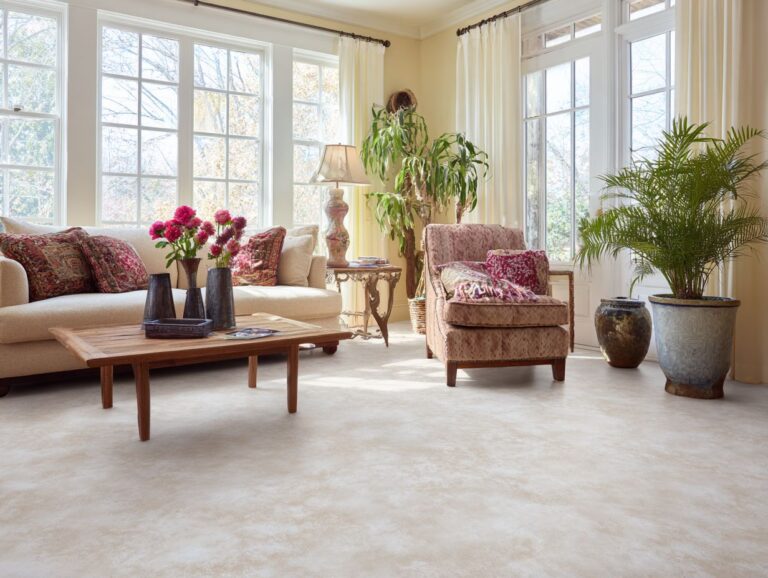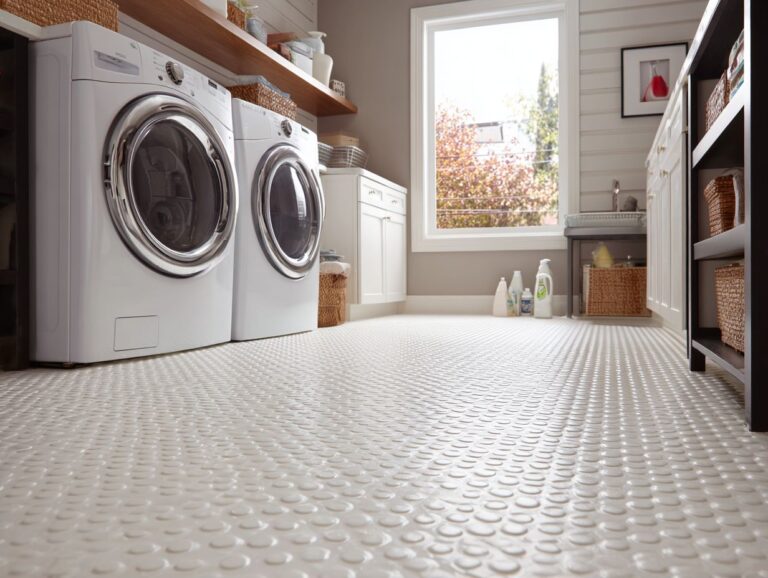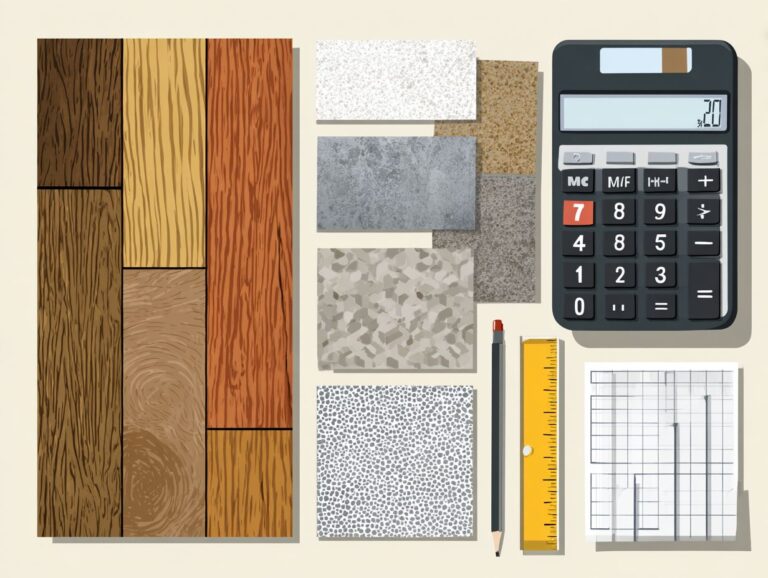Understanding Laminate Flooring – Construction & Benefits
Contents
Introduction to Laminate Flooring
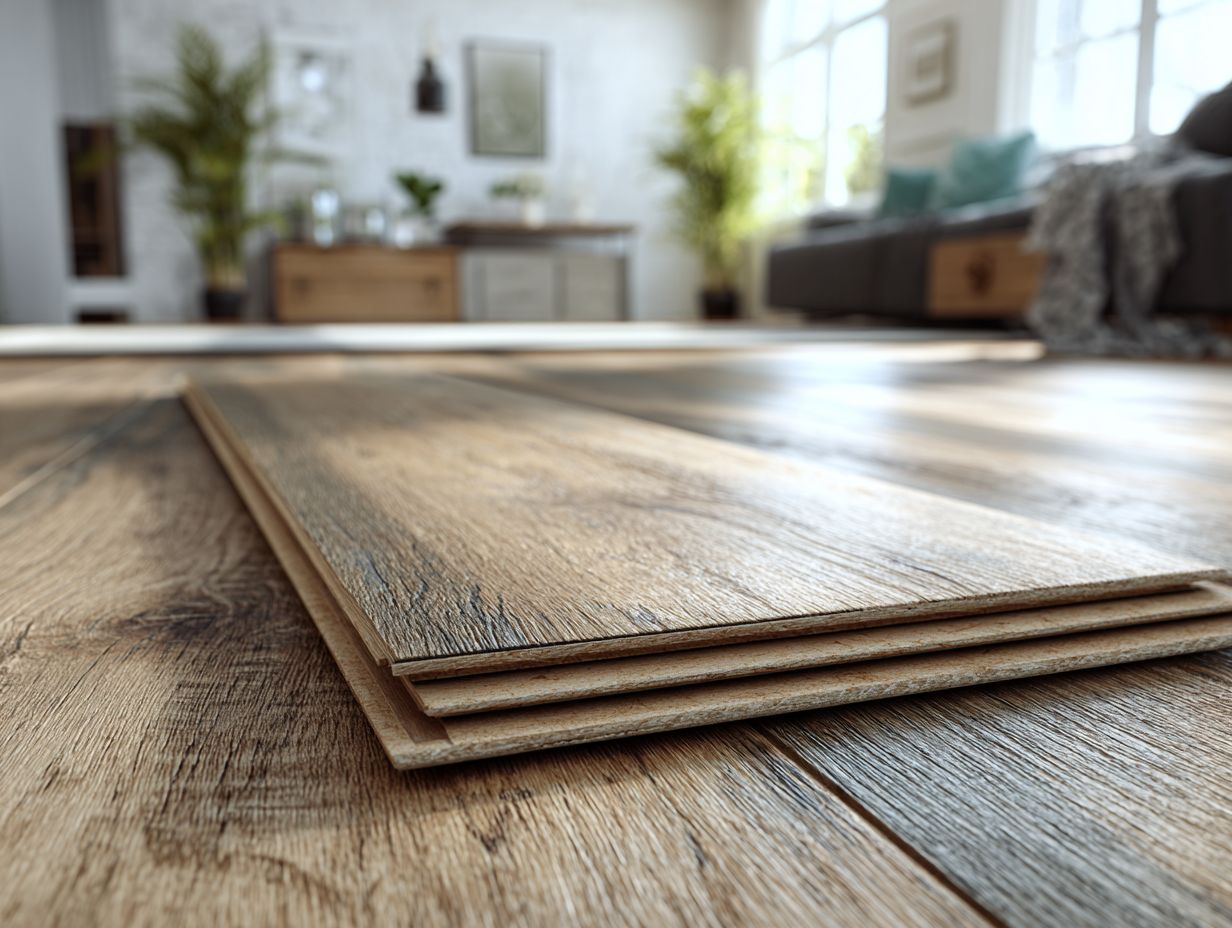
Key Takeaways:
Definition of Laminate Flooring
Laminate flooring consists of multiple layers of synthetic materials designed to resemble real wood, with a durable fiberboard core to increase longevity.
Its construction has a protective layer that guards against scratches and stains, offering an affordable option compared to hardwood.
Brands such as Pergo and Quick-Step provide laminate choices that mimic oak and maple and are simple to install with their lock-together systems.
When considering areas with high foot traffic, laminate’s resilience and lower price point-often $1 to $5 per square foot-make it a practical choice compared to solid hardwood, which can cost upwards of $8 per square foot. If you’re interested in how different wood types like oak and maple compare, our guide on Oak vs Maple vs Cherry Flooring provides valuable insights into choosing the best wood for your needs.
Laminate Flooring Market Data
Laminate Flooring Market Data
Global Market Overview: Revenue Growth
North America Market Overview: Market Volume Growth
The Laminate Flooring Market Data gives useful information about expected growth and development patterns in the industry worldwide and in North America. The data presents financial figures and expected changes in market size, showing how the industry is growing and the shifts in what customers want.
Global Market Overview encapsulates the upward trend in the laminate flooring industry, with the market valued at $57.65 billion in 2021. The forecasted revenue is projected to reach $101.31 billion by 2030 highlighting strong growth driven by factors such as more people moving to cities, home renovation trends, and consumer preference for affordable, attractive flooring options. The impressive compound annual growth rate (CAGR) of 5.8% The period from 2022 to 2030 highlights the sector’s potential for profitable opportunities for stakeholders.
- North America Market Overview indicates steady volume growth, with the market size projected to increase from 142.1 million units in 2024 to 183.1 million units by 2033. This growth signifies a CAGR of 2.71% from 2025 to 2033, reflecting a consistent demand for laminate flooring solutions driven by renovation projects and new constructions, particularly in residential sectors.
The data suggests that the laminate flooring market is on a significant growth path, with global market value nearly doubling by 2030. This growth is supported by improvements in technology which increase the durability and range of products. These factors make laminate flooring appealing to buyers looking for quality at affordable prices. In North America, the steady increase in volume shows the market is stable, giving businesses a chance to grow their services and gain more customers.
Overall, the insights from the Laminate Flooring Market Data highlight promising growth prospects, encouraging industry players to innovate and expand their market presence. Investing wisely in product development and marketing can take advantage of these trends and create conditions for success in the laminate flooring industry.
Brief History of Laminate Flooring
Introduced in the 1970s, laminate flooring has evolved dramatically from its inception as a budget-friendly option to an innovative flooring solution used worldwide.
Important events include Tarkett launching high-pressure laminate in the 1980s, greatly improving strength and design choices.
The 1990s saw the rise of click-lock installation techniques, allowing for easier DIY projects and greater accessibility for homeowners.
In the early 2000s, manufacturers started using textures and lifelike wood designs, which made laminate look just like real hardwood.
Today, advanced technologies such as water-resistant features and sustainable materials are setting new standards, catering to environmentally conscious consumers while maintaining affordability.
Construction of Laminate Flooring
Learning how laminate flooring is made shows why it is so well-liked by both homeowners and builders.
Layers of Laminate Flooring
Laminate flooring typically consists of four main layers: the backing layer, core layer, decorative layer, and wear layer, each serving a distinct purpose.
The backing layer provides moisture resistance, preventing damage from spills or humidity.
The middle part, typically made from high-density fiberboard, keeps the planks stable, so they hold their shape over time.
The decorative layer, printed with a design, adds aesthetic appeal and mimics the look of wood or stone.
The wear layer, often made from aluminum oxide, offers durability and protects against scratches and fading.
Together, these layers create a practical flooring choice that is both attractive and useful.
Core Layer Composition
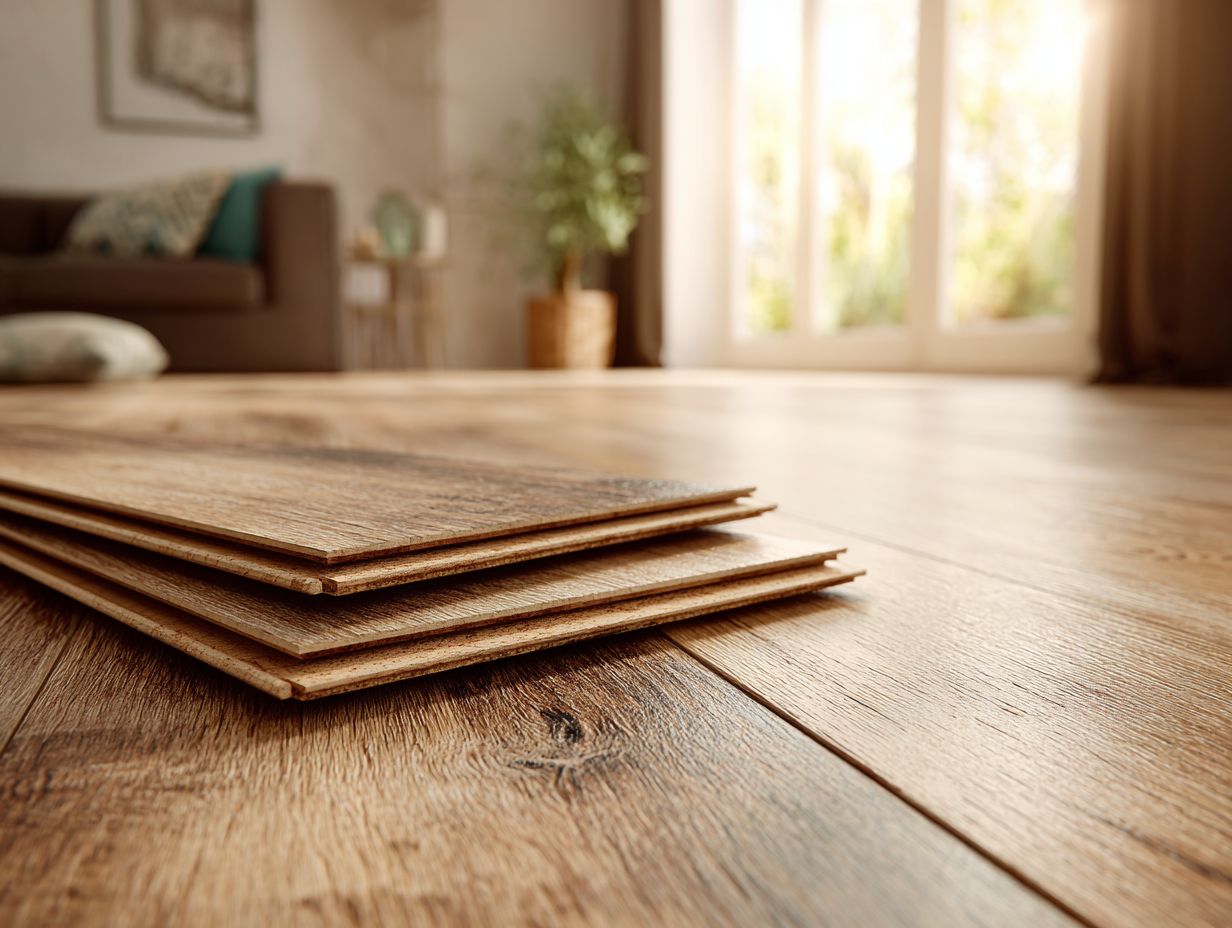
The core layer, primarily made from high-density fiberboard (HDF), provides exceptional dimensional stability and supports the overall structure of the laminate plank.
HDF’s thick makeup greatly improves the water-resistant qualities of laminate flooring, reducing the chances of it bending or expanding when it comes into contact with moisture. This strength is important in busy areas like hallways and living rooms, where floors handle a lot of use.
HDF can withstand heavy loads, ensuring longevity in residential and commercial spaces alike. For optimal performance, look for laminate flooring rated AC3 or higher, which indicates suitability for normal to intensive use.
Brands such as Quick-Step and Pergo use strong HDF in their products, which makes the floors long-lasting and attractive.
Wear Layer Characteristics
The wear layer, comprised of a tough resin, is the first line of defense against scratches, stains, and wear and tear, ensuring longevity in high-traffic areas.
This layer typically ranges in thickness from 0.3mm to 1.2mm, varying across different laminate collections.
For instance, a general residential collection usually features a wear layer around 0.3mm, suitable for moderate foot traffic. In contrast, commercial-grade laminates often offer a thicker wear layer of 0.8mm to 1.2mm, designed to withstand heavy use in retail and office environments.
Choosing the right thickness for the task is important for getting the best strength and look.
Design Layer Options
The design layer, often a high-resolution photographic layer, allows for a wide variety of visual choices, from natural wood looks to modern patterns.
Metro Floors exemplifies this versatility with collections like the Rustic Barnwood, offering warm tones and textures that mimic reclaimed wood, perfect for cozy interiors.
Conversely, the Urban Concrete collection features sleek, industrial designs that suit contemporary spaces. Many brands allow customization options, such as different finish styles and edge treatments, enabling you to tailor the flooring to your specific aesthetic.
By exploring these collections, you can select a design that seamlessly integrates with your overall decor, enhancing both style and functionality.
Backing Layer Functionality
The backing layer serves multiple functions, including moisture resistance, noise attenuation, and providing a smooth surface for installation.
A good base layer improves laminate flooring by handling issues typically found in areas with high moisture.
For instance, choosing a backing material with a water-resistant feature, like foam or cork, can effectively minimize the risk of water damage in kitchens and bathrooms.
Noise attenuation can be achieved with a thicker foam backing, which reduces sound transmission between floors.
When installing, choose a base layer that matches the manufacturer’s guidelines for optimal outcomes, resulting in a strong and cozy space.
Benefits of Laminate Flooring
Laminate flooring offers several benefits, which is why both homeowners and businesses often choose it.
It is affordable and durable. For those interested in exploring flooring options, learn more about different types of hardwood flooring and their unique characteristics.
Durability and Scratch Resistance
Laminate flooring is designed to withstand wear and tear, boasting a wear layer that provides exceptional scratch resistance-a must for households with pets.
Along with scratch resistance, laminate flooring can last up to 25 years under normal conditions. This longevity is due to its core construction, which is made from high-density fiberboard that absorbs impacts better than hardwood.
While hardwood generally shows wear after 15-20 years and can be difficult to maintain in high-traffic areas, laminate is more resistant to moisture and fading. For example, brands like Pergo offer water-resistant choices that are suitable for kitchens and bathrooms, making them a practical choice for busy families.
Cost-Effectiveness Compared to Other Flooring Types
Costing an average of $1 to $5 per square foot, laminate flooring is a budget-friendly alternative to hardwood ($5-$10) and tile ($3-$15).
Laminate flooring is simple to install, usually needing only a few tools and basic skills. For instance, with a typical DIY project, homeowners can use a simple click-lock system, eliminating the need for adhesives or nails.
Consider a 1,000 square foot living room: laminate installation might total around $2,500, while hardwood could exceed $6,000. Options like Pergo or Mohawk provide stylish finishes, further enhancing value.
The affordability and attractive look of laminate make it a great option for homes.
Easy Installation Process
With a click-lock installation method, many homeowners can install laminate flooring themselves, reducing installation costs significantly.
To start, measure the room dimensions and calculate the square footage to determine how much laminate you’ll need.
Cut the planks to fit your space using a laminate cutting tool, ensuring a clean edge. Next, prepare the underlayment, which provides cushioning and sound insulation, laying it down evenly across the floor.
Installation typically takes 1-2 hours for small rooms (up to 100 sq ft) but may extend to 3-5 hours for larger areas. By following these steps, homeowners can achieve professional results without incurring extra labor costs.
Low Maintenance Requirements
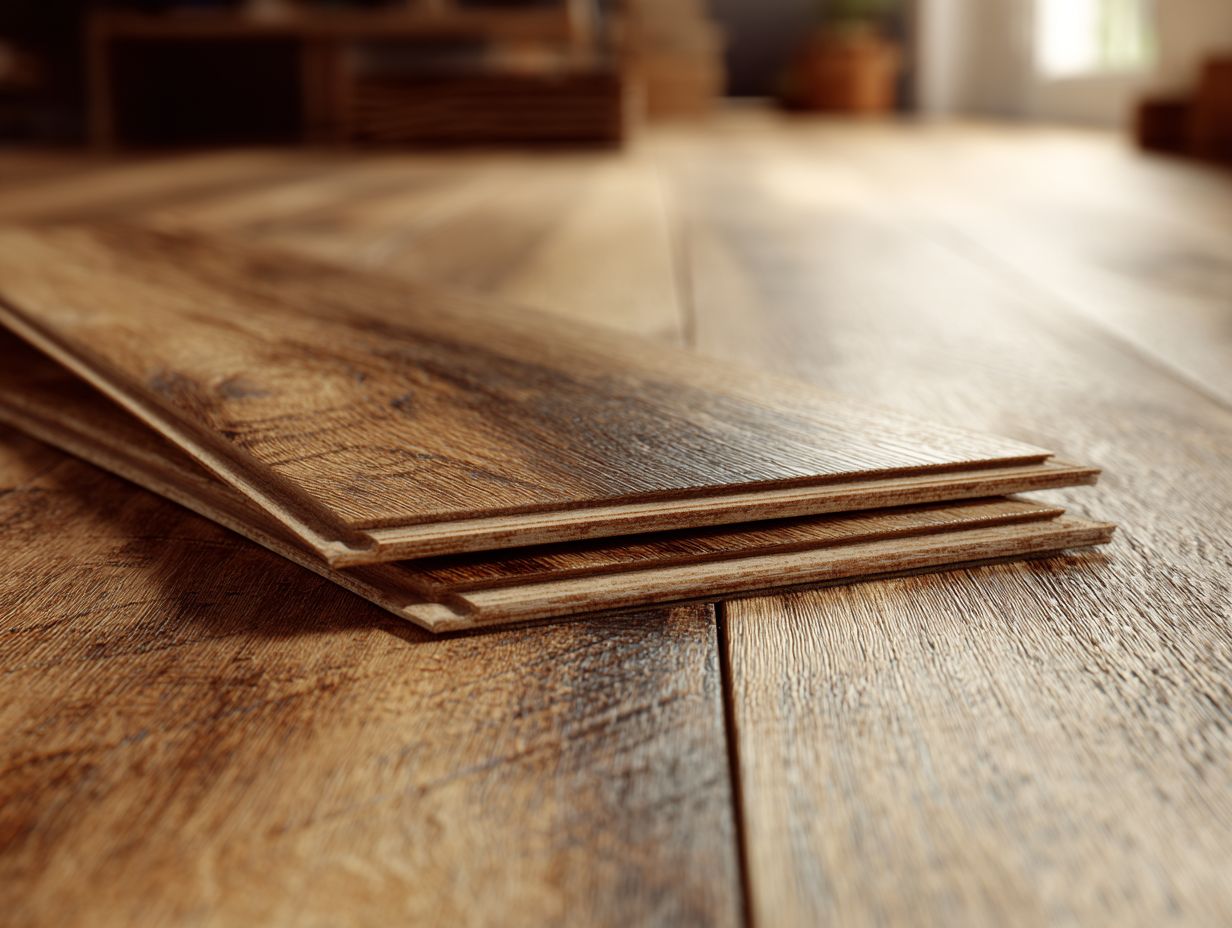
Laminate flooring requires minimal care, typically needing only regular sweeping and occasional damp mopping to maintain its appearance.
To make it last longer, use a pH-balanced cleaner made for laminate surfaces, such as Bona Hard-Surface Floor Cleaner. It’s effective at removing grime without damaging the finish.
Avoid harsh chemicals, such as bleach or ammonia, which can erode the protective layer. To tackle tough stains, use a combination of warm water and vinegar. Moisten a cloth with the mixture rather than soaking the floor.
Regularly check for scratches and use repair kits that match your laminate finish to maintain an attractive look.
Variety of Design Options
Available in a multitude of styles, textures, and colors, laminate flooring can seamlessly blend with any home decor, enhancing aesthetic appeal.
For example, Tarkett’s collections include laminate choices that look very much like real woods such as oak and hickory, and also have stylish tile designs.
Homeowners can choose from realistic textures that vary in finish, ensuring a perfect match for traditional or modern settings. To simplify installation and upkeep, consider using Tarkett’s easy-click installation system, which eliminates glue and nails.
Purchasing a high-quality underlayment will reduce noise and increase comfort, making your laminate flooring both appealing and useful.
Eco-Friendly Options Available
Many laminate flooring options now use eco-friendly materials, making them a good choice for those who are environmentally conscious.
These eco-friendly laminates often feature certifications like FloorScore, which indicates low VOC emissions, ensuring better indoor air quality.
Brands like Pergo provide various laminate flooring options made from recycled wood fibers, and Shaw Floors uses recycled materials and follows strict environmental guidelines.
By choosing these options, consumers lower their impact on the environment and make their homes healthier for their families.
When selecting laminate, check for additional certifications like GreenGuard, which further guarantee the sustainability of the product.
Comparing Laminate Flooring to Other Flooring Types
Knowing the differences between laminate flooring and other popular types, like hardwood and vinyl, helps people choose the best option for their needs.
Laminate vs. Hardwood Flooring
While hardwood offers a timeless appeal, laminate flooring provides a comparable aesthetic at a fraction of the cost, often with superior scratch resistance.
When deciding between laminate and hardwood, consider key factors such as cost, maintenance, and lifespan.
- Laminate typically costs $1 to $5 per square foot, while hardwood ranges from $3 to $12.
- Maintenance for laminate is minimal; regular sweeping and occasional damp mopping suffice.
- Hardwood floors must be refinished every 5 to 10 years, raising overall costs.
- In terms of lifespan, hardwood can last over 100 years with proper care, whereas laminate generally endures 10-25 years.
- Hardwood is a renewable resource, whereas laminate production involves more plastic, impacting its environmental footprint (our Exotic Hardwood Species Guide offers more insight into sustainable choices).
Laminate vs. Vinyl Flooring
Vinyl flooring is often considered for its water-resistant properties, yet laminate flooring offers similar benefits with a more authentic wood-like appearance.
When choosing between the two, consider moisture resistance levels: vinyl outshines laminate, particularly in bathrooms and kitchens.
Vinyl installation is often easier, frequently having click-lock systems that lower labor expenses. Laminate typically costs less upfront, ranging from $1 to $5 per square foot, compared to vinyl’s $2 to $7.
In design flexibility, laminate offers a wider variety of wood finishes, while vinyl comes in a plethora of colors and textures including realistic stone patterns.
Weigh your immediate needs and long-term preferences to make the best choice.
Laminate vs. Carpet
Unlike carpet, laminate flooring does not hold dust and allergens, making it a better choice for homes, especially for those with allergies.
Unlike carpet, which can trap dust mites and mold, laminate flooring is easy to clean with just a damp mop and mild cleaner.
Laminate floors usually last between 15 and 25 years. On the other hand, carpets may need replacement every 5 to 15 years, depending on their usage.
Laminate is resistant to stains and spills, requiring minimal maintenance. These factors contribute to a healthier living space and longer-lasting flooring investment, particularly for families with children or pets.
Summary of Key Points
In short, laminate flooring offers benefits like durability, easy installation, low maintenance, and many design options.
These advantages make laminate flooring a practical choice for homeowners. The strong surface is scratch and stain resistant, so it holds up well in busy areas.
Installation is quick; many products feature a click-lock system that requires no glue or nails. Maintenance is minimal, often requiring just a damp mop for cleaning.
Laminate comes in a vast array of styles, including wood, tile, and stone visuals, allowing customization to fit any decor. With prices ranging from $1 to $5 per square foot, it’s an economical flooring solution as well.
Final Thoughts on Choosing Laminate Flooring
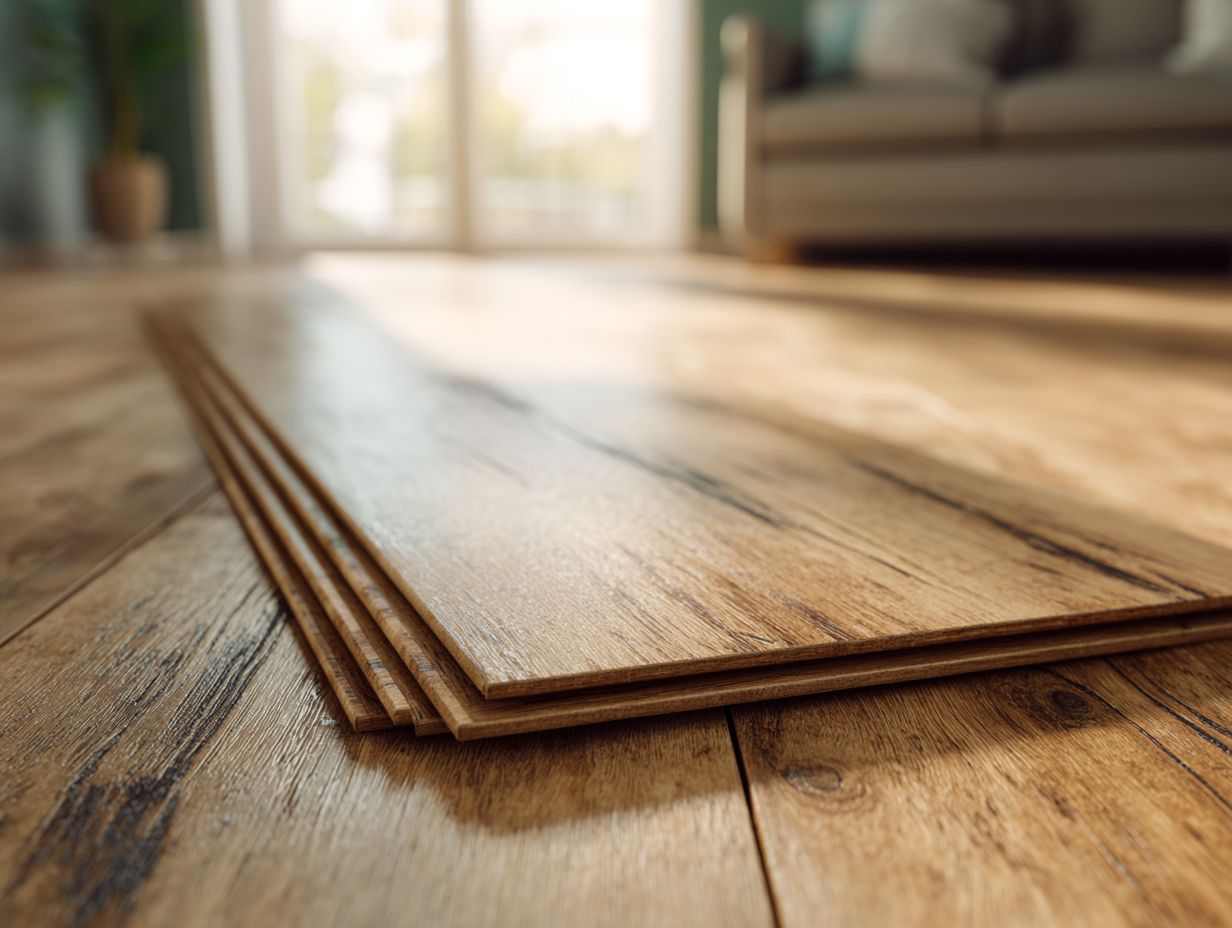
When choosing flooring, think about laminate for its affordability, long-lasting nature, and wide range of design choices that suit different preferences.
If you want laminate flooring, begin by thinking about your daily activities. If you have kids or pets, look for thicker laminate with high abrasion resistance, such as 12mm planks from brands like Pergo or Shaw.
Next, think about maintenance; many laminates are easy to clean with simple sweeping and occasional mopping. Look for realistic wood or stone patterns to fit your home style.
Remember to check for warranties, which can range from 10 to 30 years, offering assurance on your investment.
FAQs about Laminate Flooring
Answering common questions clears up confusion and provides helpful information about the benefits of laminate flooring.
Common Misconceptions
A lot of people think you cannot refinish laminate flooring, but you can fix or replace it if it gets damaged.
Laminate flooring is often wrongly assumed to be inferior to hardwood. In reality, high-quality laminate can withstand heavy foot traffic and resist scratches better than many hardwood options.
While laminate isn’t the best at handling moisture compared to other floorings, some brands offer water-resistant options, which work well in kitchens and bathrooms.
When choosing laminate, look at brands like Pergo or Mohawk. They offer long-lasting and nice-looking flooring, so you can get the advantages of this type of floor.
Frequently Asked Questions
What is laminate flooring and what is it made of?
Laminate flooring is a type of synthetic flooring that is designed to look like real wood, stone, or tile. It is made up of multiple layers, including a backing layer, a core layer, and a printed design layer, all of which are topped with a durable wear layer for added protection.
What are the benefits of laminate flooring?
Laminate flooring has many advantages, like being budget-friendly, long-lasting, and simple to clean. It also withstands scratches, dents, and stains, making it an excellent choice for busy areas. Laminate flooring comes in many styles and finishes to fit any home design.
How is laminate flooring constructed?
Laminate flooring is constructed by using heat and pressure to fuse the different layers together. The backing layer is typically made of melamine for added moisture resistance, while the core layer is made of high-density fiberboard. The printed design layer is a high-resolution image that is covered by the transparent wear layer for added protection.
Can laminate flooring be installed in any room?
Yes, laminate flooring can be installed in any room in your home. However, it is not suggested for use in rooms with high humidity, such as bathrooms and laundry rooms. It is also not recommended for outdoor use.
Is laminate flooring easy to maintain?
Yes, laminate flooring is very easy to maintain. Simply sweep or vacuum regularly to remove any dirt or debris, and wipe up spills and stains with a damp cloth. Avoid using harsh cleaning products or excess water, as it can damage the flooring.
What is the lifespan of laminate flooring?
The lifespan of laminate flooring can vary depending on the quality and maintenance of the flooring. Typically, laminate flooring can last between 10 and 25 years. To keep your flooring in good condition for a long time, follow the maintenance and care instructions.
